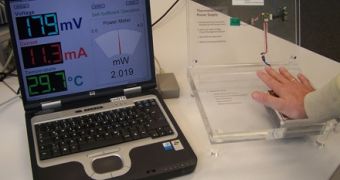A research team from the German Fraunhofer Institute developed an electronic system that is capable of working with no apparent power source apart from the energy generated by the human body. This kind of power generating system could have a lot of applications in the mobile computing industry alone, where battery life is often the greatest impediment.
What the German research team done is to create a thermoelectric generator (TEG for short) converts temperature differences of only a few degrees Celsius in electrical energy. The good news is that the heat generated by the human body is more that enough for the TEG to function, while the bad news is that at its maximum output the TEG reaches around 200mW of power which is highly insufficient for today's handheld devices and mobile computers or electronics that need at least 1W.
The TEG device is made from semiconductor elements and its power output can be increased by increasing the temperature differences between the two mediums. According to the press release from the Fraunhofer Institute concerning this innovation, "a difference of several tens of degrees would be required in order to generate enough power, but the differences between the body's surface temperature and that of its environment are only a few degrees".
"Only low voltages can be produced from differences like these," explains Peter Spies, manager of this sub-project at the IIS. "We combined a number of components in a completely new way to create circuits that can operate on 200 millivolts. This has enabled us to build entire electronic systems that do not require an internal battery, but draw their energy from body heat alone." Already there are a number of working prototypes in different stages of completion that require an extremely low power to function. Such electrical devices that draw only 50 millivolts could operate on the energy delivered by a TEG which is exposed to a difference of temperature of only 0.5 degrees centigrade. "Electricity can be generated from heat anyplace where a temperature difference occurs," claims Spies. "That could be on the body, on radiators to meter the heating costs, when monitoring the cooling chain during the transport of refrigerated goods, or in air conditioning systems."

 14 DAY TRIAL //
14 DAY TRIAL //